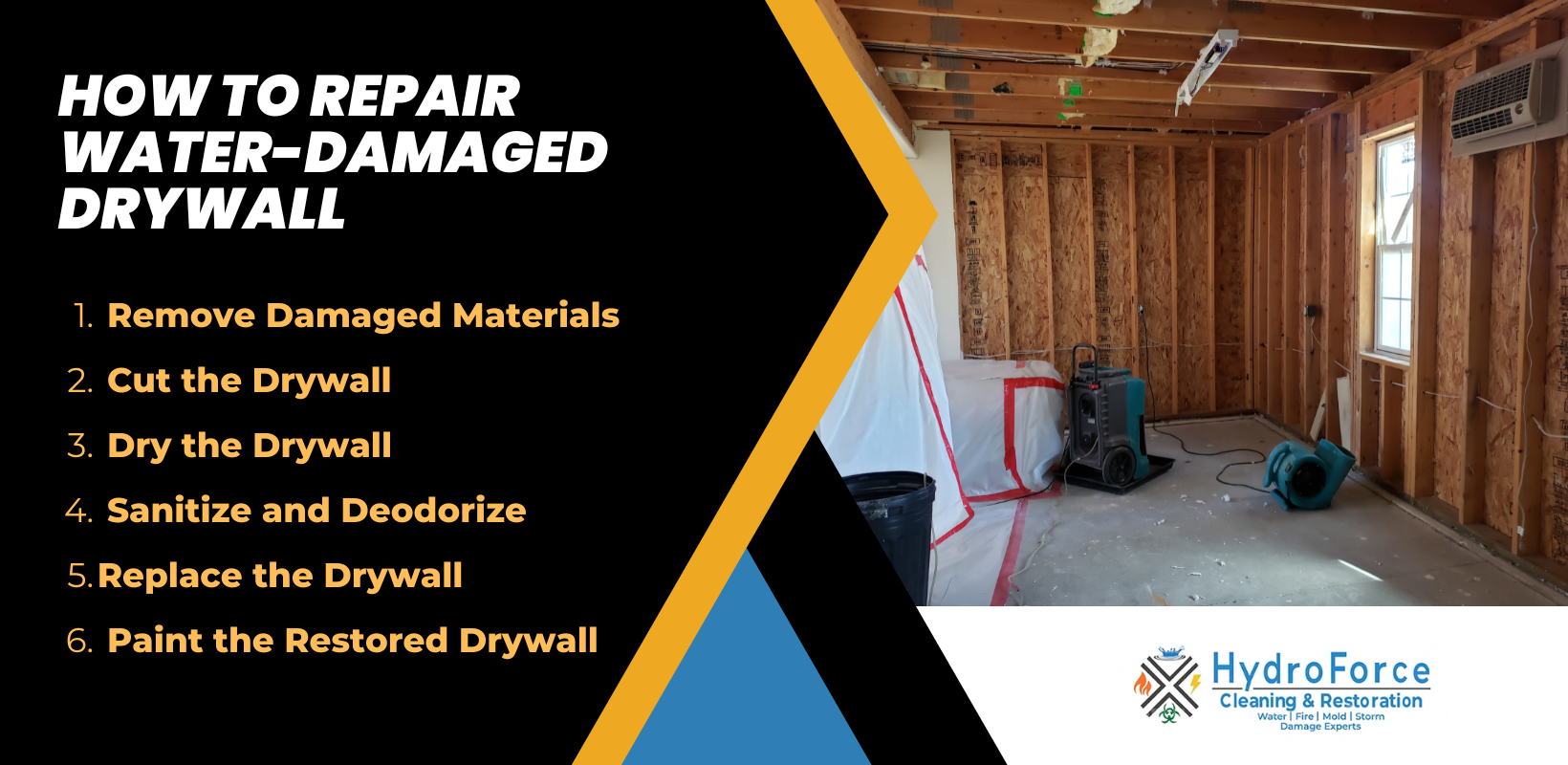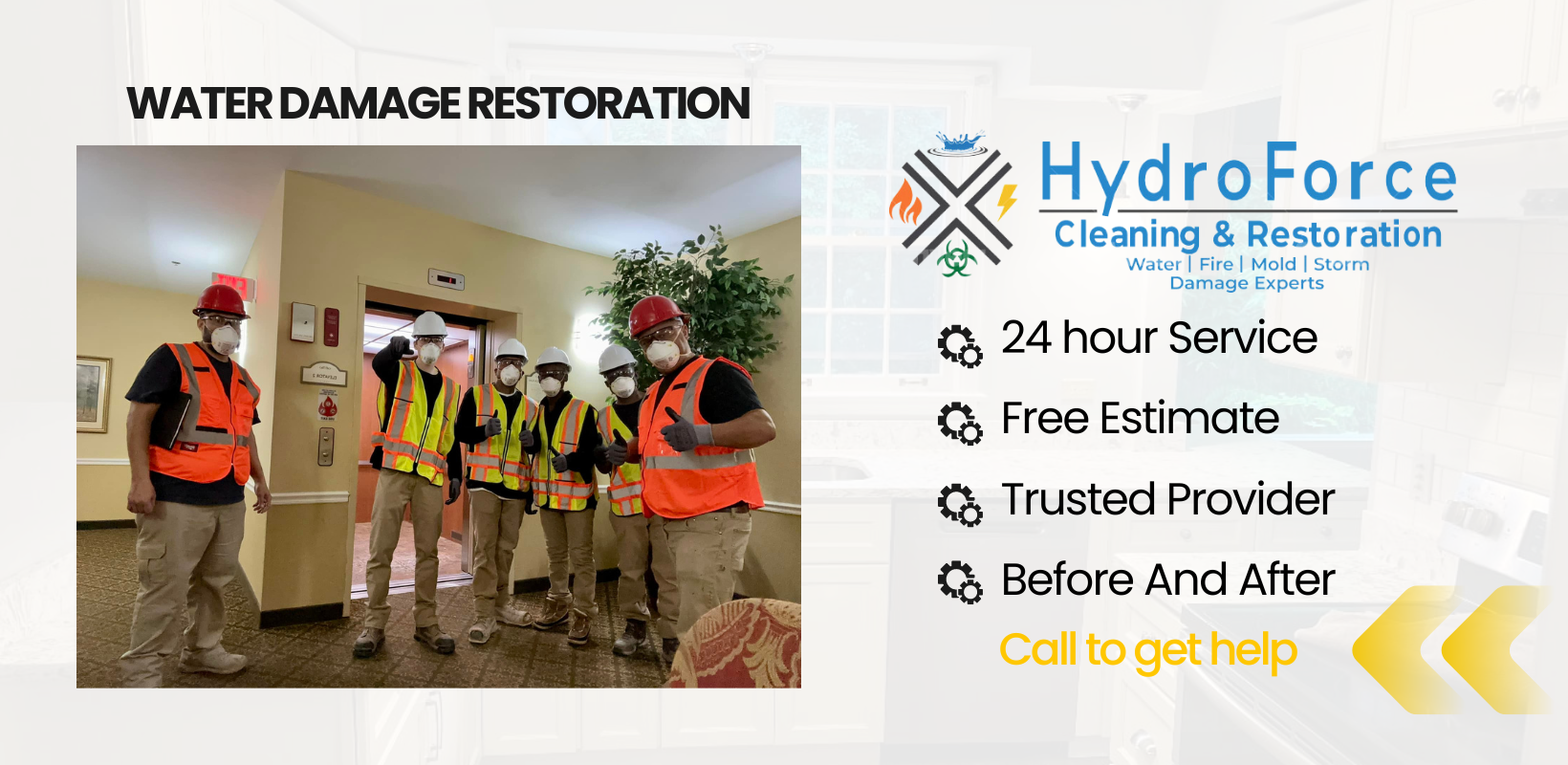How to Repair Drywall Affected by Water Damage
Home » How to Repair Drywall Affected by Water Damage
Water damage in your home or business can develop gradually or occur suddenly. Regardless of how it happens, it’s essential to address it immediately. Delaying repairs can lead to further deterioration, resulting in higher restoration costs.
Drywall is particularly vulnerable to water damage because it is a porous material. Water-damaged drywall may experience issues such as cracks, peeling, or buckling, which can evolve into both cosmetic and structural problems. Prolonged water damage also increases the risk of mold and mildew growth. If you notice water damage in your drywall, ensure it is repaired promptly to prevent these complications.
How Do I Know If I Have Water Damage in My Walls?
Remember that drywall is porous and can retain moisture even after the water appears to have dried. In cases of flooding, whether from overflowing bathtubs or burst pipes, it’s safe to assume your drywall is compromised, risking mold and mildew growth if untreated.
For smaller leaks, damage might not be immediately obvious. Watch for signs like peeling walls, cracking paint, bubbling wallpaper, soft drywall, musty odors, or stains. Such issues often arise from slow pipe leaks, aging seals around doors and windows, or clogged gutters.
What You Should Know Before Repairing Water-Damaged Drywall
If you decide to repair the water-damaged drywall yourself, there are a few things you need to know:
- If overhead flooding has led to wet drywall, there’s a risk that the ceiling is compromised and could collapse. In such cases, it’s essential to hire a professional water restoration company to address the damage.
- If the damage is caused by sewage backup, you will need to call a professional to address the damage. This type of cleaning may end up involving biohazard materials which should be handled by a professional.
- You will need to find and address the source of the water or moisture. Get rid of the standing water and dry out any water-damaged areas. If you leave the water sitting, you will end up with more damage to your drywall.
What is the Process of Repairing a Water-Damaged Wall?
First, clear the area by removing water-soaked furniture and building materials. Also, remove wet carpet and padding, or at least pull it back to allow the floor to air out. When you are ready to repair the drywall, follow these steps:

1. Be Safe
If the drywall needs to be removed, make sure that you wear the proper respiratory protection in case your drywall has asbestos. Also, make sure to switch off the circuit breakers and remove any non-affected electrical outlets before any wall material is torn out.
2. Get Rid of Any Damaged Materials
You will need to figure out how much drywall needs to be cut out. If the flooding level was less than two and a half feet, then the wall material needs to be removed up to a height of four feet. This will help when you reinstall the full sheets of drywall.
If you have more than two and a half feet of damage to your drywall, then you will need to remove the drywall up to eight feet or to the ceiling junction, whichever is higher.
If you cannot tell the level of damage, inspect the drywall and remove areas that are cracked, crumbling, or sagging. If the wall is damp, and the water is clean (such as from a burst pipe) you can try to dry it. You may need to remove the damaged wall studs, cabinets, and even ceilings and cut out damaged portions of the drywall.
3. Cut the Drywall
It is important to follow the proper steps to cut out sections of water-damaged drywall. Here are a few things you will need to do:
- Mark the wall properly with a straight line right above where the water has stopped wicking using a chalk line.
- You will need to cut along the chalk line about one-half to three-quarters through the drywall using a utility knife.
- Remove any damaged portions of the drywall by knocking a small hole in it with a hammer. Then gently pull the drywall out.
- Once the drywall has been cut out and removed, make sure to take the insulation out. If it is made of plastic foam, you can leave it as it is and let it dry.

4. Dry Out the Wall
Once you remove all the water-damaged drywall, it is important to then dry the area around and inside the wall. Make sure to use specialized blowers and dehumidifiers and open all windows and doors. Using fans will help increase the airflow behind the walls and they should be running for at least two days so that the studs and flooring can fully dry.
5. Properly Sanitize and Deodorize
Use a chemical sanitizer to help prevent mold and bacteria between the walls. Do not use bleach as it will not help. If there are residual odors, make sure to use an ozone machine and keep it running for at least eight hours. While the machine is running, leave the area.
6. Replace the Water-Damaged Drywall
Once you’ve sanitized the area, you will need to hang new drywall. Make sure to accurately measure the size of the hole so that you know how much to cut out from the new sheet of drywall. Put four drywall clips around the hole and secure each one using a drywall screw.
Then insert the drywall pieces and secure them into the drywall clips. Do not tighten the drywall screws too much. Instead, use drywall tape and joint compound and blend it with the existing drywall. Then as a final step, you will need to sand the area a few times to smooth the wall surface out.
7. Paint the Restored Drywall
Make sure that the joint compound is fully dry and then paint the wall with a primer so that it can seal properly. Then you can paint the whole wall so that you have a fully uniform color.
Professional Water Damage Restoration

Leaks behind walls and above ceilings can significantly damage the drywall because its porous nature allows the water to spread through it. It is very important to recognize signs of water damage to the drywall, such as bubbling, sagging, stains, and wet spots so you can take action before the water causes more serious structural damage.
Following the steps outlined above can help you repair water-damaged drywall, but some situations may be too complicated to handle yourself. If you experience extensive water damage to your drywall or do not feel confident in addressing the problem yourself, you can reach out to our professionals at HydroForce Cleaning and Restoration.
At HydroForce Cleaning and Restoration, we offer a full range of water damage restoration services to address issues such as leaks that lead to water-damaged ceilings and drywall. Our technicians can identify the source of the water and uncover the full extent of the water damage to determine the best course of action. We used advanced drying equipment to thoroughly dry affected drywall and we can also remove and replace drywall that has been heavily damaged.
You can call HydroForce 24/7 at (630) 835-0862 if you need professional water damage restoration services in the Chicago, IL area.
Privacy Policy | Terms & Conditions | 630-835-0862
